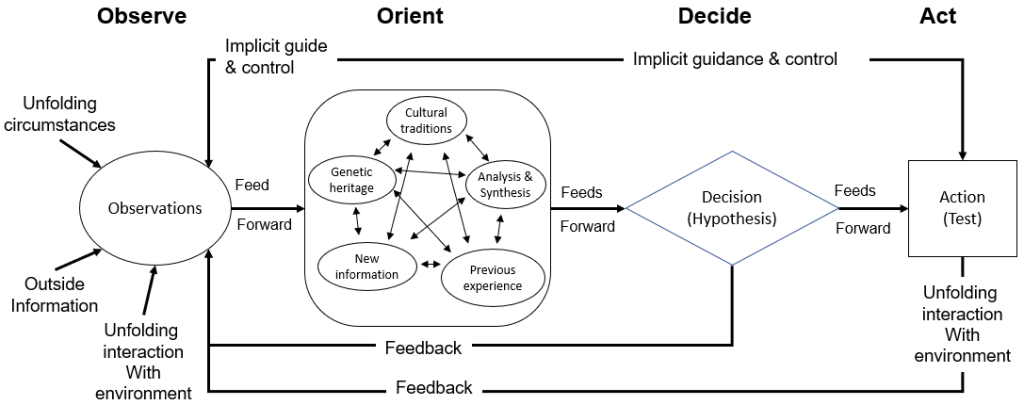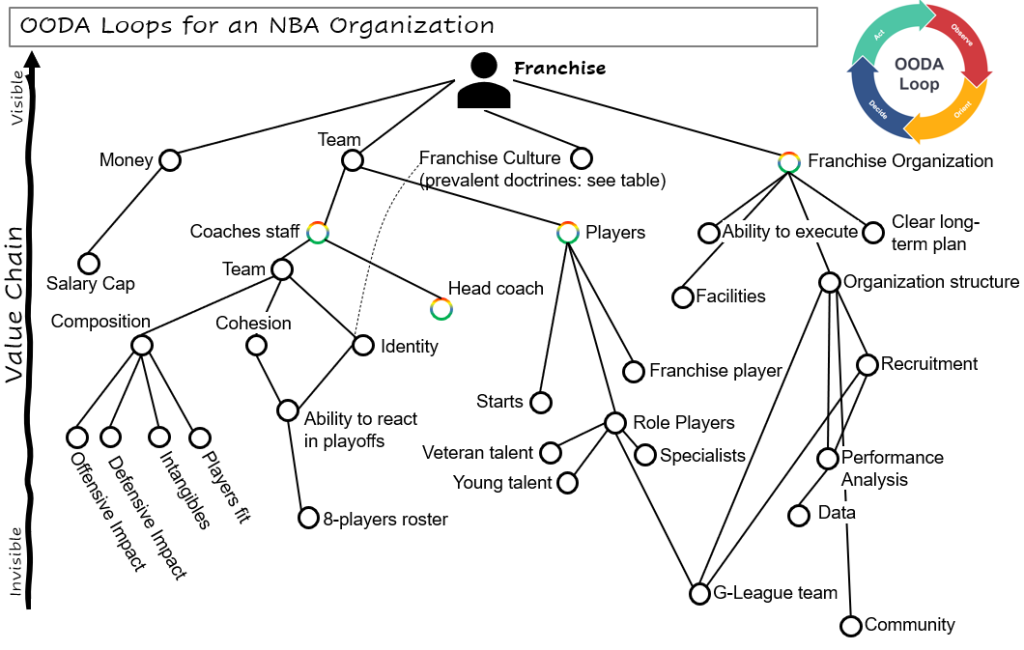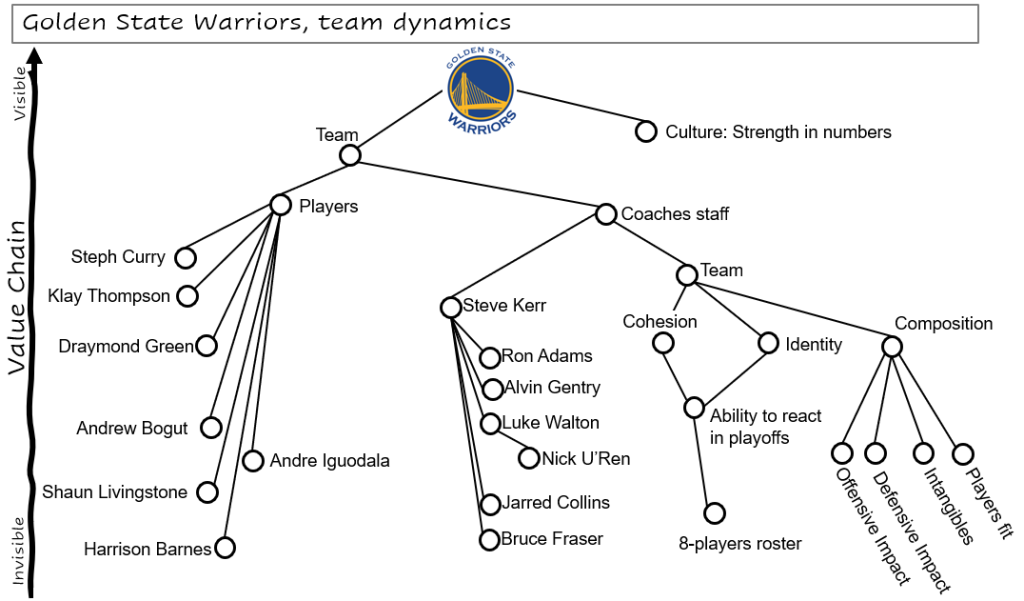John Boyd is considered by many to be the greatest air combat theorist in history, and he is also the creator of the OODA (observe, guide, decide, act) loop. Boyd argued that if a fighter pilot rigorously goes through the OODA loop faster than his enemy, he will maximize the probability of beating the enemy in air combat.
The OODA loop is represented visually like this:

Now think about the professional basketball context and think about how many OODA loops are happening in these organizations: from the General Manager, through the coaches till the players.
NBA competition is full of repetitive loops
There are OODA loops at different levels.
Regular season is full of loops
Let’s start with the regular season: 24 weeks with an average of 3 games till complete 82 games.

Ask a rookie and the first thing he will tell you after his first season in the NBA will be: “this is exhausting, you do a bad game and you do not have time to think about it because the next morning you are working on the following night game 1000 miles away”.
Then, we go into the play-offs that is composed by 4 series where you have to win 4 games per series (don’t forget the travels).
OODA loops in individual games
Now, let’s look into an individual game, the teams plan, prepare and work considering the concept of possessions. They are not obsessed on this KPI (Key Performance Indicator) but they measure it and use it to understand if they are playing at the desired pace. The pace of the game is a key factor, if you dominate it, your chances to win increases.

The ability to change this pace and adapt to a pace that is not “yours” is key too.
Learning approach through the loops
Today, in the professional basketball, there are two types of teams:
- The ones that looking for a common pattern of execution that makes them to succeed.
- The ones that have a defined pattern of execution but are continuously learning, trying to adjust and react to new challenges.
The first ones are looking for a core set of gameplays that make them to win, the second ones execute that core set of gameplays and now are looking to go beyond and learn how to adjust to critical situations (minimize their weaknesses).
Under the pace of all these loops, NBA teams learning process have accelerated too much, making the things to evolve faster. For instance, we can see how keep high performance on the teams is harder than 20 years ago.
Under these circumstances, the teams that are still looking for their core execution “way to win” will find out into the playoffs with teams that are able to observe, orient, decide and act quickly, and in that time, according to Boyd, you’ll be knocked down.
Some examples
One of the more invisible moves of Golden State Warriors franchise for the average fan is the use of leading edge technology and practices to build a learning culture in all areas of the organization and be able to listen and react as quick as possible to events. This journey started in 2010, they won the Sports Business Awards as the Team of the Year in 2014, and they won the first championship in 2014-2015.
It’s also very popular the implementation of data based decisions on recruitment done by Daryl Morey in Houston Rockets. It’s not only the recruitment process what can be done in a different way, there are so many angles of the organization which can be assessed in a different way and take advantage in front of your competitor.
OODA loops in the NBA franchises
I see so many OODA loops in the NBA franchises and how they need to react to the different situations they face along the season: specially play-offs.

The Franchise organization have:
- Questions about the season’s expectations, versus real execution of the season.
- Observe players injuries, orient the situation with coaches, decide, and act to face the pending season.
- Questions about the real performance of team, coaches, and individual players.
- Questions about real fit that team is having, and assessment of how this fit is working and evolving.
- Questions about how to maximize the revenue of the organization: testing new threads of revenue, maximizing existing one, measure fan KPIs…
The coaches team have:
- Questions about what team combination is performing better.
- Questions about how to improve the team fit, performance.
- Questions about how to protect themselves against potential mismatches.
- Questions about how to hide game patterns, weaknesses when facing the play-offs.
- Observe potential personal conflicts in favor of players fit.
- Questions about the individual contribution of each player.
- Evaluation of choices during the game: game tempo, pace, decisions, changes, hide “options” for play-off, test options for play-off.
The players have:
- Real time decisions on the court.
- Observe how a game was played, orient the work done, decide changes, play the next game (act).
- Observe how the season is being played, orient the work with coaches, decide changes, play the next game (act).
Playoffs adjustments
At the end of the regular season and in preparation of the play-offs the media specialists make a list of core capabilities each team has, weaknesses they have to minimize and there are always “adjustments” that are revealed as potential reactions to a bad situation.
There are teams that are so dominant and they do not have the need to do adjustments, but this is less and less frequent.
Some adjustments are invisible, but others are very visible. I will review a very popular “adjustment” that worked well and was considered key into the change of the Finals of 2014-15, when after game 3, when GSW was losing 2-1 against Cavaliers, in a series dominated by Lebron James, Golden State was not able to find a way to break this dominance.
To me the important thing was the work dynamic happening when the problem was there, how it was proposed, analyzed and lead. I was not there in first person, so probably I’m losing a lot of details. But let’s go for it.
2014-15 NBA Finals Cavalier lead 2-1 against GSW
The scenario after game 3 of the series was not good for GSW, the feeling of not being able to minimize the impact of Lebron James in the court was a real threat. GSW was playing really well, but this point was not working well and they were heading game 4 in Cleveland which potentially will leave them with a 3-1 in the series.
Something has to be change, but what?
The team that years was basically composed by:

The team dynamics cannot be well represented here as there are so many lines of communication happening between players, coaches and other stakeholders.
The point is that one person: Nick U’Ren (special assistant to the head coach and manager of advanced scouting) was watching the game 3 of 2013-14 Finals between San Antonio Spurs and Miami Heat. During this game San Antonio made an unorthodox change: add Boris Diaw into the starting line instead of Tiago Splitter. The speed of the game and their focus trying to minimize Lebron James impact was key during that series. Could that provoke a positive change in GSW way of execution?
That night, Nick U’Ren proposed assistant coach Luke Walton a comparable move: pulling center Andrew Bogut, for small forward Andre Iguodala. This change is very risk as Bogut ability to protect the ring was not comparable to the ability of Iguodala to do it, in addition to that, they did not tested it during the season as Bogut was always in the starting line.
Luke Walton bought the idea and commented to Steve Kerr. The idea was debated during the following day and all pros and constrains were discussed. Finally the decision was done: Andre Iguodala was starting in Game 4.
Steve Kerr disclosed the change, and that meant for him being and unstoppable series of questions about that change. Every single interview had a question to understand why this change was being done, where the decision came from, why they did not trust on their center, etc. Steve Kerr avoided to disclose details and he always put himself as accountable of that drastic decision: he thought it was a healthy change that tried to shake their way to execute.
After the series were won, Steve Kerr disclosed that the idea came from Nick U’Ren. I’m sure they were discussing so many changes and adjustments to their main way to execute the basketball they were doing during that season.
My point is that the dynamics in the teams and the healthy communications between people leading different responsibilities are key for an organization that want to win. These dynamics have to be build before you face difficult moments, because in a competitive environment the time to react and the chances of making changes and succeed are not always available. Make the right decisions is tough, and being able to execute them is tougher.
Golden State won that Series and Andre Iguodala was appointed as MVP of these Finals. This is a nice story to remind, but now look ahead into the current season, look into the loops the teams are burning and how they are preparing themselves for the play-offs. Look into the maturity moment each team is, and their ability to learn and incorporate changes. Professional sports are very challenging, and it’s a good place to observe how they overcome real situations.